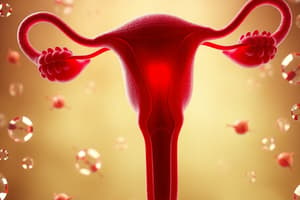Podcast
Questions and Answers
What is the main component of the male reproductive system responsible for producing sperm and testosterone?
What is the main component of the male reproductive system responsible for producing sperm and testosterone?
- Seminiferous tubules (correct)
- Epidermis
- Fallopian tube
- Ovary
Which female organ is responsible for the development and release of eggs during ovulation?
Which female organ is responsible for the development and release of eggs during ovulation?
- Fallopian tube
- Ovary (correct)
- Pituitary gland
- Uterus
What process involves the travel of the egg from the ovary down the fallopian tube towards the uterus?
What process involves the travel of the egg from the ovary down the fallopian tube towards the uterus?
- Ovulation (correct)
- Implantation
- Menstruation
- Spermatogenesis
Which cells support the development of germ cells during spermatogenesis in males?
Which cells support the development of germ cells during spermatogenesis in males?
In which structure do mature sperm accumulate before being transported through the vas deferens?
In which structure do mature sperm accumulate before being transported through the vas deferens?
What stimulates the production of sex hormones and the development of gametes?
What stimulates the production of sex hormones and the development of gametes?
What evolutionary adaptations have been observed in reptiles, amphibians, and fish related to reproduction?
What evolutionary adaptations have been observed in reptiles, amphibians, and fish related to reproduction?
Which factor has research linked to potential effects on ovarian signaling pathways?
Which factor has research linked to potential effects on ovarian signaling pathways?
What is a key factor in fertility and reproduction that has been studied related to recurrent spontaneous abortion (RSA)?
What is a key factor in fertility and reproduction that has been studied related to recurrent spontaneous abortion (RSA)?
Studying reproductive systems provides insight into which of the following areas?
Studying reproductive systems provides insight into which of the following areas?
Flashcards are hidden until you start studying
Study Notes
Understanding Reproductive Systems
Reproductive systems are complex networks of organs and processes responsible for sexual reproduction. They vary among species, reflecting their unique evolutionary adaptations and ecological requirements. The human reproductive system, for instance, consists of the male and female systems, both sharing similar structures and functions despite their differences.
Male Reproductive System
In males, the main component is the testis, which produces sperm and hormones like testosterone. These sperm-producing regions, called seminiferous tubules, contain specialized cells known as germ cells. Sertoli cells support the development of these germ cells during spermatogenesis. The epididymis, where mature sperm accumulates, is another important structure. It ensures the sperm's viability before they are transported through the vas deferens to mix with other fluids in the ejaculate.
Female Reproductive System
The primary organ in females is the ovary, where the eggs (ova) develop and are released during ovulation. Ovaluation occurs monthly, following the menstrual cycle. During ovulation, the egg travels down the fallopian tube towards the uterus. If fertilization occurs, the zygote implants itself into the uterine wall, where it develops into an embryo and eventually a fetus.
Hormonal Regulation
Both systems are regulated by hormones produced by the pituitary gland and the hypothalamus. For example, the release of luteinizing hormone (LH) and follicle-stimulating hormone (FSH) stimulates the production of sex hormones and the development of gametes.
Evolutionary Adaptations
As seen in reptiles, amphibians, and fish, internal fertilization and parental care have evolved along with external fertilization and larval stages of development. These diverse strategies reflect the environmental conditions under which these animals reproduce.
Medical Perspectives
Research continues to uncover key factors in fertility and reproduction, such as the role of non-coding RNA in immune mechanisms related to recurrent spontaneous abortion (RSA). Additionally, studies like the one discussing obesity's effect on ovarian signaling pathways reveal potential links between weight and reproductive health.
Conclusion
Understanding reproductive systems involves exploring various aspects of biological organization, from basic cellular processes to whole-organism interactions. By studying these systems, we can gain valuable insight into reproductive health, infertility, and endocrine disorders.
Studying That Suits You
Use AI to generate personalized quizzes and flashcards to suit your learning preferences.




